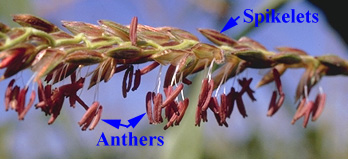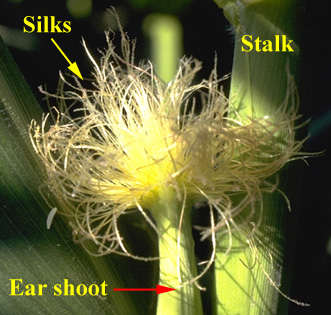 SEX in the Corn Field: SEX in the Corn Field:
How's It Done?
Dr. R.L. (Bob) Nielsen
Agronomy Department,
Purdue University
West Lafayette, IN
47907-1150
Office ph. 765-494-4802
INTERNET
rnielsen@purdue.edu
To better understand potential problems that
can occur during pollination, you should first understand how the pollination
process is orchestrated. Remember that corn has both male flowers and female
flowers on the same plant (a flowering habit called monoecious for you trivia
fans.) When the male flowers in the tassel mature, anthers emerge from the
spikelet flowers, and pollen is dispersed through pores that open at the tips
of the anthers.
Pollen Shed.
 The anthers
are those gizmos that hang from the tassel during pollination. Under a
magnifying lens, anthers look somewhat like the
double-barrel of a shotgun. Don't
mistake anthers for the pollen itself. Pollen is contained inside the anthers. The anthers
are those gizmos that hang from the tassel during pollination. Under a
magnifying lens, anthers look somewhat like the
double-barrel of a shotgun. Don't
mistake anthers for the pollen itself. Pollen is contained inside the anthers.
The yellow 'dust-like' pollen that falls from the anthers of
the tassel actually represent two to five million individual, nearly
microscopic, spherical, yellowish-translucent pollen grains. Each pollen grain
contains the male genetic material necessary for fertilizing the ovary of one
potential kernel.
All of the pollen from a single anther may be
released in as little as three minutes. An individual tassel may take as long
as seven days to finish shedding its pollen, although the greatest volume of
pollen may be shed during the second and third day of anther emergence. Because
of natural field variability in plant development, a whole field may take as
long as 14 days to complete pollen shed.
If the anthers are wet, the pores will not
open and pollen will not be released. Thus, on an average Indiana summer
morning following a heavy evening dew, pollen shed will not begin until the dew
dries and the anther pores open. Cool, cloudy, humid conditions also delay the
onset of pollen shed. Similarly, pollen is not shed during rainy conditions.
So, growers need not worry about pollen being washed off the tassel during
heavy rainfall.
Silks.
 The silks that
emerge from the ear shoot are the functional stigmas of the female flowers.
Every potential kernel (ovule) on an ear
develops its own silk that must be pollinated in order for the ovary to be
fertilized and develop into a kernel. Typically, up to 1000 ovules form per
ear, even though we typically harvest only 400 to 600 actual kernels per ear. The silks that
emerge from the ear shoot are the functional stigmas of the female flowers.
Every potential kernel (ovule) on an ear
develops its own silk that must be pollinated in order for the ovary to be
fertilized and develop into a kernel. Typically, up to 1000 ovules form per
ear, even though we typically harvest only 400 to 600 actual kernels per ear.
Silk elongation begins 7 to 10 days
prior to silk emergence from the husk. Complete silk emergence from an ear
generally occurs within two to seven days. Silks from the basal portion of the
ear typically emerge first, while the tip silks generally emerge last.
Pollination and
Fertilization.
For those of you serious about semantics,
let's review two definitions relevant to sex in the corn field.
Pollination is the act of transferring the pollen grains to the silks by
wind or insects. Fertilization is the union of the male gametes from the
pollen with the female gametes from the ovary. Technically, pollination usually
occurs successfully (i.e., the pollen reaches the silks), but unsuccessful
fertilization results in poor kernel set on the ears.
Pollen grain germination occurs within
minutes after a pollen grain lands on a receptive silk. A pollen tube,
containing the male genetic material, develops and grows inside the silk, and
fertilizes the ovary within 24 hours. Pollen grains can land and germinate
anywhere along the length of an exposed silk.
Pollen grain germination occurs
within minutes after a pollen grain lands on a receptive silk. A pollen tube,
containing the male genetic material, develops and grows inside the silk, and
fertilizes the ovary within 24 hours. Pollen grains can land and germinate
anywhere along the length of an exposed silk.
Silk
clipping by certain insects like the
corn rootworm beetle not only removes
viable silk tissue, but also injures a certain length of the remaining silk.
Generally, silk length on these injured ear shoots must be at least 1/2 inch to
ensure that a sufficient length of uninjured silk tissue is exposed for pollen
germination to occur.
Silk receptivity to pollen grain
germination exists up to 10 days after silk emergence. After 10 days, silk
receptivity decreases rapidly. Silk elongation continues until pollination is
successful, although elongation eventually ceases as unfertilized silks
senesce.
 Return to The
Corn Growers Guidebook , a WWW resource for corn management systems in
Indiana and the eastern CornBelt. Return to The
Corn Growers Guidebook , a WWW resource for corn management systems in
Indiana and the eastern CornBelt.
End of Document |